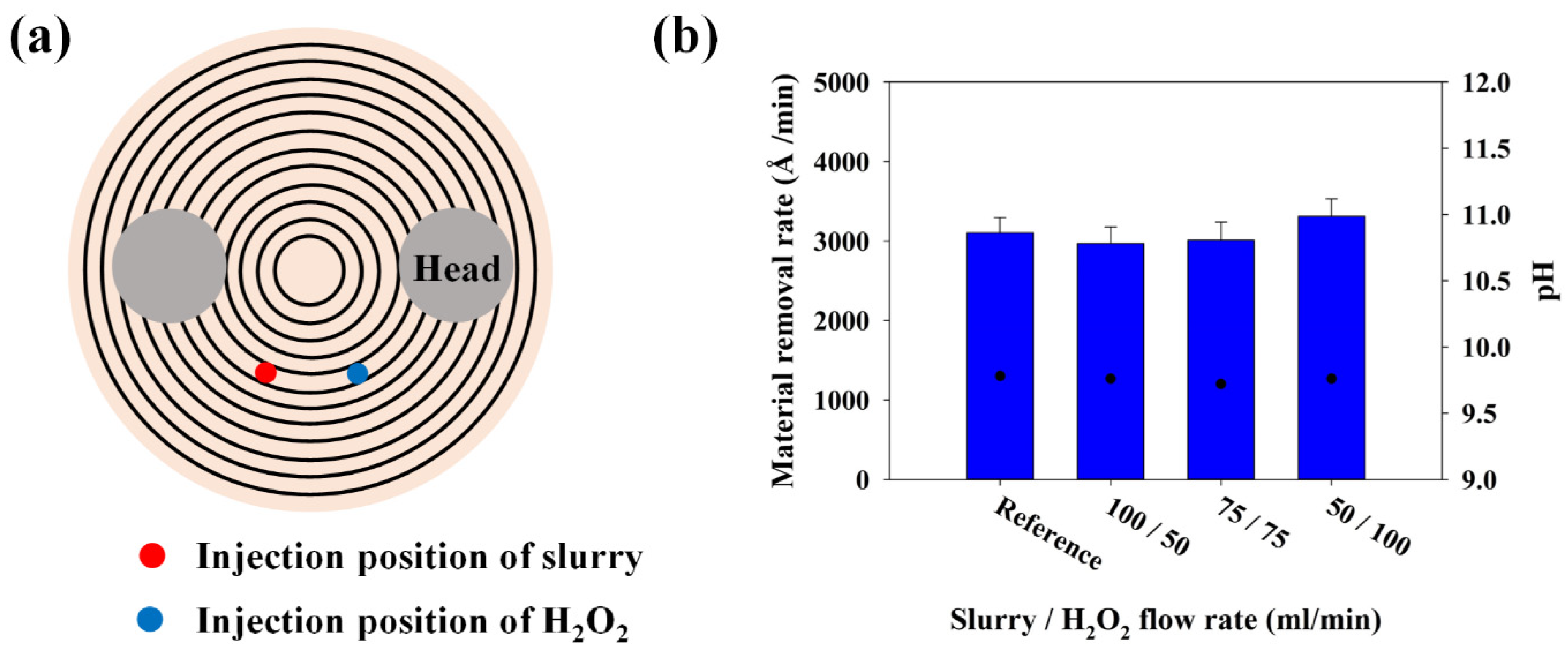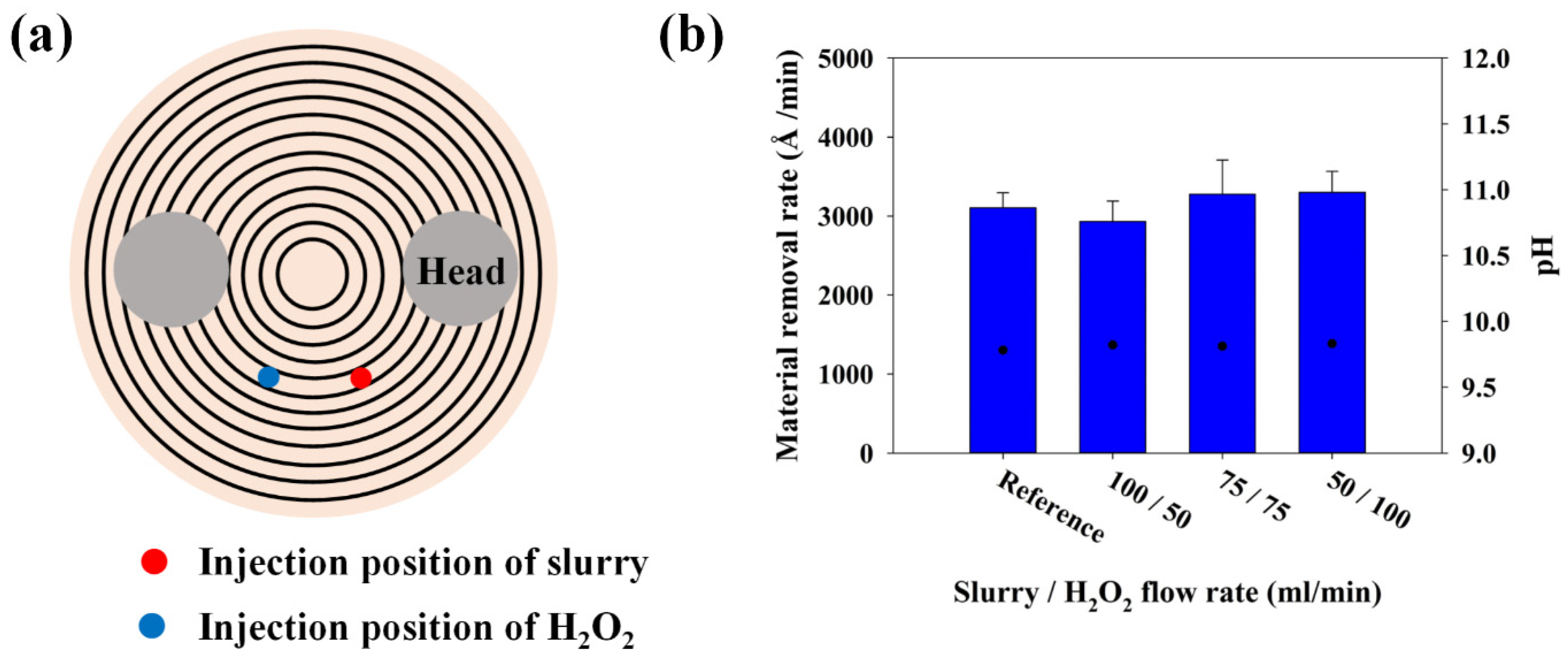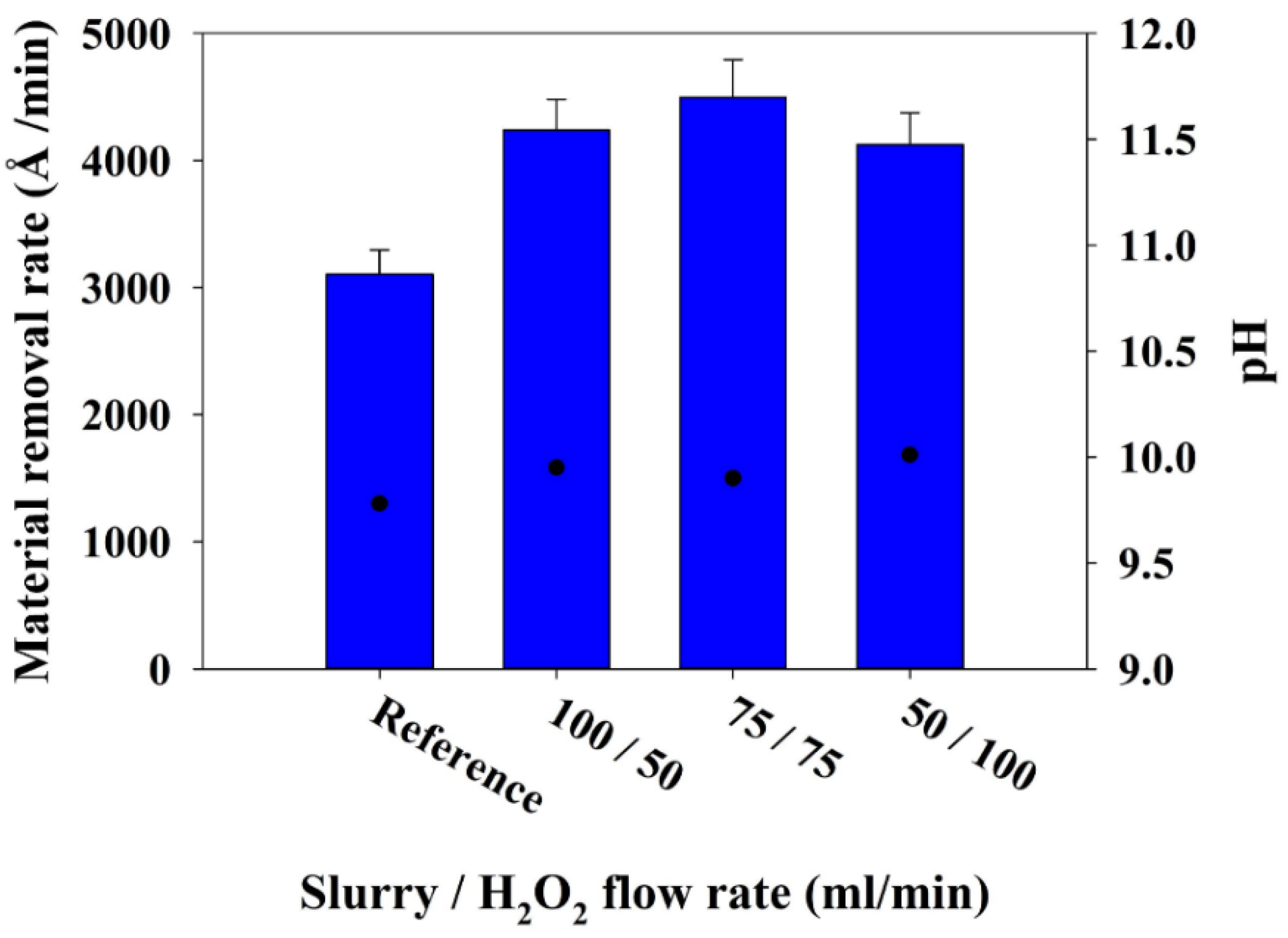Investigation of the Two-Way Injection Slurry-Supply Method for the Cu CMP Process
Abstract
1. Introduction
2. Materials and Methods
2.1. Slurry-Supply System
2.2. Slurry Preparation
2.3. CMP Evaluation
3. Results and Discussion
4. Conclusions
Supplementary Materials
Author Contributions
Funding
Institutional Review Board Statement
Informed Consent Statement
Data Availability Statement
Conflicts of Interest
References
- Wu, L.; Chen, K.; Cheng, S.; Lee, B.; Shu, C. Thermal decomposition of hydrogen peroxide in the presence of sulfuric acid. J. Therm. Anal. Calorim. 2008, 93, 115–120. [Google Scholar] [CrossRef]
- Mori, Y.; Uemura, K. Total-reflection X-ray fluorescence analysis for semiconductor process characterization. Spectrochim. Acta Part B At. Spectrosc. 2003, 58, 2085–2092. [Google Scholar] [CrossRef]
- Kondoh, E.; Toyama, M.; Jin, L.; Hamada, S.; Shima, S.; Hiyama, H. Growth kinetics of Cu surface layers in H2O2–BTA aqueous solutions. Jpn. J. Appl. Phys. 2020, 59, SLLF01. [Google Scholar] [CrossRef]
- Yan, C.; Liu, Y.; Zhang, J.; Wang, C.; Zhang, W.; He, P.; Pan, G. Synergistic effect of glycine and BTA on step height reduction efficiency after copper CMP in weakly alkaline slurry. ECS J. Solid State Sci. Technol. 2016, 6, P1. [Google Scholar] [CrossRef]
- Li, R.; Du, Y.; Li, Y.; He, Z.; Dai, L.; Wang, L.; Wu, X.; Zhang, J.; Yi, J. Alloying Strategy for High-Performance Zinc Metal Anodes. ACS Energy Lett. 2022, 8, 457–476. [Google Scholar] [CrossRef]
- Nicoll, W.; Smith, A. Stability of dilute alkaline solutions of hydrogen peroxide. Ind. Eng. Chem. 1955, 47, 2548–2554. [Google Scholar] [CrossRef]
- Hiroki, A.; La Verne, J.A. Decomposition of hydrogen peroxide at water-ceramic oxide interfaces. J. Phys. Chem. B 2005, 109, 3364–3370. [Google Scholar] [CrossRef] [PubMed]
- Kim, J.; Kwak, D.; Park, J.; Kubota, T.; Kim, T. Effects of aging time in hydrogen peroxide-glycine-based Cu CMP slurry. Mater. Sci. Semicond. Process. 2022, 140, 106343. [Google Scholar] [CrossRef]
- Xu, Q.; Chen, L.; Yang, F.; Cao, H. Influence of slurry components on copper CMP performance in alkaline slurry. Microelectron. Eng. 2017, 183, 1–11. [Google Scholar] [CrossRef]
- Aksu, S.; Doyle, F.M. Electrochemistry of copper in aqueous glycine solutions. J. Electrochem. Soc. 2001, 148, B51. [Google Scholar] [CrossRef]
- Silva-Molina, R.; Duarte-Moller, A.; Orrantia-Borunda, E.; Parra-Berumen, R.L.; Álvarez-Ramos, M.E. The role of pH on the second harmonic response of glycine sodium nitrate (GSN). J. Phys. Sci. 2011, 6, 885–890. [Google Scholar]
- Liao, X.; Sampurno, Y.; Zhuang, Y.; Philipossian, A. Effect of slurry application/injection schemes on slurry availability during chemical mechanical planarization (CMP). Electrochem. Solid-State Lett. 2012, 15, H118. [Google Scholar] [CrossRef]
- Jha, A.; Stoll, D.; Tseng, W.T.; Wu, C.; Yang, J.C.; Philipossian, A. Application of Slurry Injection System (SIS) to Advanced Deep-Trench (DT) CMP. In Proceedings of the ICPT 2017, International Conference on Planarization/CMP Technology, Leuven, Belgium, 11–13 October 2017. [Google Scholar]
- Bahr, M.; Sampurno, Y.; Han, R.; Philipossian, A. Slurry injection schemes on the extent of slurry mixing and availability during Chemical Mechanical Planarization. Micromachines 2017, 8, 170. [Google Scholar] [CrossRef]
- Wu, C.; Sampurno, Y.; Liao, X.; Zhuang, Y.; Borucki, L.; Theng, S.; Philipossian, A. Effect of pad groove design on slurry injection scheme during interlayer dielectric chemical mechanical planarization. ECS J. Solid State Sci. Technol. 2015, 4, P272. [Google Scholar] [CrossRef]
- Wang, T.; Zhao, D.; He, Y.; Lu, X. Effect of slurry injection position on material removal in chemical mechanical planarization. Int. J. Adv. Manuf. Technol. 2013, 67, 2903–2908. [Google Scholar] [CrossRef]
- Sampurno, Y.; Borucki, L.; Philipossian, A. Effect of slurry injection position on slurry mixing, friction, removal rate, and temperature in copper cmp. J. Electrochem. Soc. 2005, 152, G841. [Google Scholar] [CrossRef]
- Philipossian, A.; Mitchell, E. Slurry utilization efficiency studies in chemical mechanical planarization. Jpn. J. Appl. Phys. 2003, 42, 7259. [Google Scholar] [CrossRef]
- O’Connor, G.; Lepkova, K.; Eksteen, J.J.; Oraby, E.A. Electrochemical behaviour of copper in alkaline glycine solutions. Hydrometallurgy 2018, 181, 221–229. [Google Scholar] [CrossRef]




| Flow Rate (mL/min) | MRR (Å/min) | pH |
|---|---|---|
| Reference | 3105.4 | 9.78 |
| 100/50 | 2969.99 | 9.76 |
| 75/75 | 3010.31 | 9.72 |
| 50/100 | 3313.02 | 9.76 |
| Flow Rate (mL/min) | MRR (Å/min) | pH |
|---|---|---|
| Reference | 3105.4 | 9.78 |
| 100/50 | 2931.78 | 9.82 |
| 75/75 | 3276.01 | 9.81 |
| 50/100 | 3301.85 | 9.83 |
Disclaimer/Publisher’s Note: The statements, opinions and data contained in all publications are solely those of the individual author(s) and contributor(s) and not of MDPI and/or the editor(s). MDPI and/or the editor(s) disclaim responsibility for any injury to people or property resulting from any ideas, methods, instructions or products referred to in the content. |
© 2023 by the authors. Licensee MDPI, Basel, Switzerland. This article is an open access article distributed under the terms and conditions of the Creative Commons Attribution (CC BY) license (https://creativecommons.org/licenses/by/4.0/).
Share and Cite
Bae, C.; Kim, J.; Kwak, D.; Oh, S.; Kim, T. Investigation of the Two-Way Injection Slurry-Supply Method for the Cu CMP Process. Appl. Sci. 2023, 13, 3758. https://doi.org/10.3390/app13063758
Bae C, Kim J, Kwak D, Oh S, Kim T. Investigation of the Two-Way Injection Slurry-Supply Method for the Cu CMP Process. Applied Sciences. 2023; 13(6):3758. https://doi.org/10.3390/app13063758
Chicago/Turabian StyleBae, Chulwoo, Juhwan Kim, Donggeon Kwak, Seungjun Oh, and Taesung Kim. 2023. "Investigation of the Two-Way Injection Slurry-Supply Method for the Cu CMP Process" Applied Sciences 13, no. 6: 3758. https://doi.org/10.3390/app13063758
APA StyleBae, C., Kim, J., Kwak, D., Oh, S., & Kim, T. (2023). Investigation of the Two-Way Injection Slurry-Supply Method for the Cu CMP Process. Applied Sciences, 13(6), 3758. https://doi.org/10.3390/app13063758






